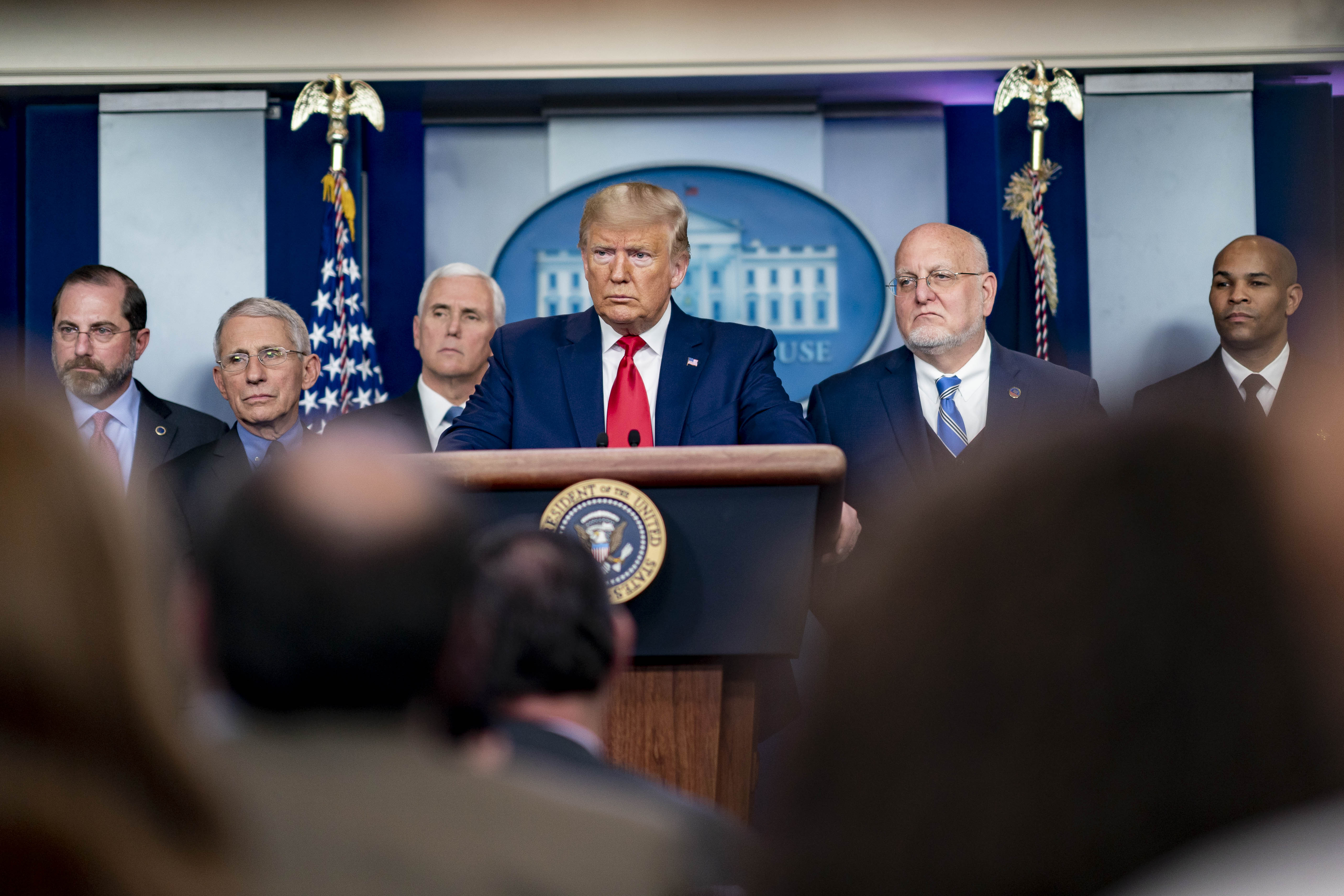Coronavirus
Winning the War on Coronavirus
The governments of the US, UK, and other nations have made real progress, but they must go much further in being transparent about their vision of how to win the war on coronavirus, and what they are doing to achieve it.

A report released by Imperial College London researchers on Monday shook the world. The report gave a glimpse into the coronavirus’s battle plan. It was to kill over two million Americans and at least a half-million Brits.
Thanks to the wartime mobilization by the people of both nations, we can feel confident that we have thwarted its plan. There is very little chance that, after the lockdowns and social distancing occurring around the world, coronavirus is still on track to infect and kill as many people.
But we are only at the very beginning of what will be a long, difficult, and deadly war, and things are changing quickly. To balance saving lives with minimizing social disruption, Imperial College scientists foresee societies engaging in several, weeks-long waves of social distancing between now and the fall of 2021. By then, most experts expect we will have a vaccine. We could get one sooner, but few believe we will have proven a vaccine’s safety and effectiveness sooner than 12 months.
The events of recent days and past epidemics, including the 1918 flu that killed 50 to 100 million people, prove that strong governmental action and transparency are the keys to winning the public’s trust, which is the key to winning the war.
There is a one-to-one relationship between transparency and trust. The more transparent the government is the more people will trust it. And the more people trust the government, the more effective public health measures, particularly social distancing, will be.
The governments of the US, UK, and other nations have made real progress, but they must go much further in being transparent about their vision of how to win the war on coronavirus, and what they are doing to achieve it.
The war on coronavirus
On Monday, I published a manifesto calling on Congress to take seven concrete actions to address the pandemic crisis. I am happy to report that President Donald Trump and Congress took major actions on all seven recommendations, including the first and most important, which was to treat the virus as a foreign enemy.
President Trump has embraced the “kill the virus” message and adopted a wartime posture. The president is visibly more comfortable today with his role as commander-in-chief of a nation at war than he appeared last week. This is not a war President Trump chose but he knows that it is a war he must fight and win.
War metaphors are appropriate when society as a whole is faced with a grave threat. I am against using war metaphors on most issues, including for fighting drug addiction, cancer, and climate change. But in this case, “killing” and “war,” are the right metaphors because they dramatically focus our attention, motivate us to urgent action, and help us to transcend our selfish natures in service of humankind’s collective interest.
The metaphors work at individual and collective levels. We kill the coronavirus directly by washing our hands with soap, disinfecting surfaces, and with our immune systems after it attacks us. We are at war with the virus in that saving our lives and our economies requires collective actions similar to those taken during wars.
At the same time, there is an important difference between the war on coronavirus and other wars. With today’s war, there is little to no need for secrecy. Indeed, secrecy in China allowed the virus to spread while transparency in South Korea saved lives. And secrecy dangerously undermines public trust in government, which will undermine public compliance with critical public health measures, particularly social distancing.
Winning the war on coronavirus will require strong societal discipline around social distancing. The Imperial College scientists propose letting up on radical social distancing and other measures only when local hospital intensive care unit (ICU) cases decline to 50 total, and re-imposing them when they reach some higher multiple, say 100, 200, 500, or more.
Given that COVID-19 victims are likely to exceed hospital and ICU beds in Europe and the US for several more weeks, it could be early summer before ICU cases drop back to around 50.
And we should take these numbers figuratively, not literally. Cities, states, and nations could trigger micro-suppressions, including radical social distancing, at higher or lower ICU bed availability, depending on much and how quickly they can expand hospital capacity.
Many expect, but we do not know for certain, that the spread of the virus will slow in the summer and pick back up next fall and winter. Scientists and historians believe that if we relax our defenses too much, the virus will strike back, and could end up taking many lives that we could have otherwise saved.
“In 1918 many cities imposed restrictions, lifted them too soon, then reimposed them,” wrote 1918 flu historian John M. Barry. “Covid-19’s average incubation period is more than double influenza’s, so compliance may have to be sustained for months, and openings and closings may also have to be repeated.”
There is still much we do not know, including how many people will become infected, and how many will die. Imperial College’s scientists assumed 81 percent of the public would become infected at some point during the duration of the virus. Mortality rates in cities and nations range at least ten-fold, from 0.7 percent to over seven percent in Italy.
The New York Times has published a COVID-19 mortality calculator, which allows readers to adjust infection rates from one to 70 percent, and a mortality rate from 0.1 to three percent, to estimate various forecasts of total US deaths, from 3,300 to seven million.
The actions we take in terms of coronavirus suppression and COVID-19 treatment will determine how many people die, and how massive of an impact our actions have on society and the economy.
The war has to be understood as a whole. Greater hospital capacity means more lives saved but also might mean less social distancing.
A radical increase in testing may help societies decide when and how to let up on strict social distancing measures. Widespread testing, the tracking of virus carriers, as done in South Korea, and the declaration of some cities as free of the virus, may allow for greater freedom of movement.
However, it is still not clear whether we are on track to produce sufficient tests at a low enough cost to achieve this and, if we are, by when. The Trump administration must do more in this regard to provide transparency into the current and future status of testing.

Nations, not states, win wars
Around the US, and the world, governors, hospital executives, doctors, and nurses are pleading for personal protective equipment (PPE), and reporting that they are having to make their own masks, re-use masks, and go without proper PPE, thereby exposing themselves to coronavirus.
President Trump yesterday invoked the Defense Production Act, but at today’s press conference said, “[The] federal government’s not supposed to be buying vast amounts of items and then shipping, you know. We’re not a shipping clerk. The governors are supposed to be, as with testing, the governors are supposed to be doing it.”
But wars are ultimately the responsibility of the federal government, which Trump acknowledged, saying “we’ll help out wherever we can and we can buy in volume.” That’s great news, and the president will go a long way if he can clarify what exactly the federal government is doing and what it is considering doing.
Vice President Pence told a reporter that 3M is making 35 million masks per month, but experts estimate the US will need 3.5 billion masks. Including the pledge of five million masks from the Department of Defense’s own stockpile, our total national stockpile sits at around 35 million—one percent of our projected need.
The Trump administration must be similarly transparent about what it is doing and not doing to build ventilators. Knowing how many ventilators there are is one of the factors that will determine hospital capacity, which will help determine when local governments should trigger micro-suppressions.
American industry leaders want to help. After at first denying the seriousness of the crisis, Elon Musk announced yesterday he would convert his Tesla factory to make ventilators. President Trump must ask Tesla and other automakers to do so, just as President Roosevelt asked Ford and other automakers to make bombers at the beginning of World War II.
If state and federal governments fail to maintain adequate supplies of PPE, they will not only put the health and safety of frontline health care workers at risk, they will threaten the entire health care system with collapse. High exposure to COVID-19 has already infected 2,629 Italian doctors and nurses even though many wore PPE. Without adequate PPE, that number will be even higher.
The Trump administration must thus do more to produce masks and other PPE and the ventilators hospitals need to deal with the coming flood of COVID-19 victims. China is a major bottleneck in most existing supply chains.
PPE is not easy to manufacture and so strong federal action is required to replace missing links in the chain. If that requires creating or nationalizing firms, then that’s what we should do. Lives, and the broader society and economy, are at stake.
Finally, President Trump must also be more clear and transparent about what the Federal Emergency Management Agency (FEMA), the national guard, and the US military are doing. It appears that relations between Trump and the governors of New York and California have improved. That is great news. But now we need much more information about what the wartime mobilization plans are.
Why we must stay focused
Humankind has proven it is capable of rapid and radical social distancing and thus should be able to carry out Imperial College’s plan for future micro-suppressions, or something similar. While young people have made headlines partying in Florida, and attending rock concerts in the UK, I believe we will soon see major behavior changes by people under the age of 30 in response to widespread condemnation of such behaviors.
At the same time, as we enter economic recession or, worse, economic depression, individual and collective opposition to social distancing will rise. Workers will need and want to work. Employers will want to make money. Economically desperate people will do desperate things.
Rising opposition to social distancing could manifest at the individual level as well as politically. People may make the case for loosening or ending social distancing. Already we have seen people openly ask why they are being required to sacrifice to prevent a few more deaths of the sick and elderly.
Growing opposition to existing and future social distancing will worsen the spread of coronavirus and may even threaten the functioning of society. Popular resistance to social distancing can be met either through social norming (i.e., moralizing) or through coercion. In order to protect our freedoms as much as possible during this war, the focus of societies and governments must be on the use of as much voluntary, rather than coercive, action as possible.
As people lose jobs, business, and even lives to the economic recession and perhaps depression, some people may argue that we should reduce social distancing, even at the cost of more deaths, to increase economic growth. Societies are unlikely to decide that they want to just “get the deaths over with” and accept COVID-19’s plan to wipe out millions of their citizens in return for higher economic growth. But people will set limits on what they are willing to do and spend, to reduce deaths, either explicitly, through laws, or implicitly, through behaviors.
That means that the focus of societies and governments should be on “no regrets” policies, such as PPE and ventilator production, testing, and sharing information. They will build the trust required for repeated periods of social distancing.
The deadly coronavirus raises important questions about America’s relationship with China, but for now, national leaders including President Trump should make clear that our enemy is the coronavirus, not China. We will need to work with China for the next one to two years to defeat the coronavirus.
The message from President Trump and other national leaders should be that all of humankind has, for now, a single enemy. We need to defeat coronavirus now and figure out the post-war world order later.
The alternative to trust, truth, and transparency is unthinkable. Noted 1918 flu historian Barry, “society is based on trust. Not knowing whom or what to believe, people also lost trust in one another. They became alienated, isolated. Intimacy was destroyed.”
The Trump administration and other governments are making progress in winning the public’s trust. They should keep it up by stating more clearly what they are doing to manufacture the PPE, ventilators, and other equipment the doctors, nurses, and other health care workers on the frontline of our war on COVID-19 need to succeed and stay safe.
Correction: An earlier version of this article noted that experts in California estimated that over half of its citizens will be infected by coronavirus over the next eight weeks. However this estimation was calculated prior to lockdown measures which have been in place since Monday.






